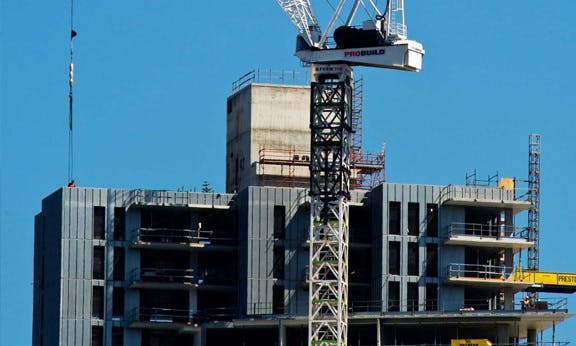Fingers pointed wrong way in dodgy building material scandal

Construction sites across Australia are plagued by substandard materials that put lives at risk. A recent spate of incidents involving exploding glass balustrades in Melbourne and shower screens in Perth are only the latest manifestations of a longstanding problem.
It’s a situation fuelled by profit-hunting and presided over by a toothless regulator with close ties to the industries it’s overseeing. Over the last decade, the list of deadly materials that have been uncovered includes poorly manufactured glass panels, flammable cladding, non-compliant electrical wiring and asbestos in everything from ceiling tiles to toys.
The finger of blame is most often pointed at dodgy Chinese manufacturers, with undertones of racism coded into the implication that China is less technologically sophisticated or concerned about health than the West.
Absent from the conversation is the fact that Australian bosses specify, order and import these materials for construction; and they do it in the knowledge that the risk of any repercussion is small.
When a preventable tragedy occurs such as London’s recent Grenfell Tower fire, the response from “industry leaders” and their lobbying bodies is to apportion blame elsewhere. According to Elizabeth McIntyre, chair of the Building Product Innovation Council (BPIC), the government “should be doing everything in their considerable power to stamp out this endemic problem of product and building non-compliance once and for all”.
Even if a supplier is taken to court, the fines are minuscule. In May, Infinity Cables, a company responsible for supplying faulty electrical cable to an estimated 40,000 homes across Australia, was fined $18,000. Four years after a nationwide voluntary recall began, only 54 percent of the 4,313 km of cabling sold has been identified and fixed. What remains in thousands of houses across the country is known to be at risk of causing electric shock or fire.
In a separate 15 June media release, McIntyre said, “BPIC would like to reassure residents that Australia has regulations and legislative safeguards that are unparalleled elsewhere”.
In fact, in the instance of electrical cabling, there is no legislative requirement that it be tested before being offered for sale or supply in Australia. A NSW Fair Trading spokesperson confirmed that electrical cable “does not need to be tested and approved before it is put on the market”.
In another example, several safety conditions were removed from the Australian standards for design, construction and installation of walkways, stairways and ladders. An engineering company challenged the changes in the Federal Court, claiming that Standards Australia, the peak non-government standards development body, had engaged in “misleading and deceptive conduct” by asserting that the new standards “make it more safe and less risky”. The case was dismissed on a technicality.
During the technical review process, a Standards Australia technical committee member who objected to the removal of the safety conditions was replaced by Master Builders Australia with another staff member who would vote to approve the alterations.
Following the Grenfell Tower fire disaster, but three years after the Lacrosse fire in Melbourne’s Docklands, a Victorian task force investigating non-compliant building cladding has been established. It is headed by former Liberal premier Ted Baillieu and former Labor deputy premier John Thwaites.
Yet it is already known that flammable cladding covers around 70 buildings in the Melbourne CBD alone. A 2014 audit pointed that out. The faulty cladding that accelerated the Lacrosse fire is still on the building and the builder, LU Simon, has been given until 2018 to remove it. Former Metropolitan Fire Brigade chief Peter Rau told the Age, “I wouldn’t allow my kids to live in the building. It’s just too big a risk in its current state”.
So what other recourse is there?
The CFMEU has placed a ban on the installation of cladding that has not been tested by an accredited Australian laboratory. National secretary Dave Noonan told News Corp Australia, “Our members are saying to us they don’t want to be complicit in building buildings that later could catch fire and potentially kill people … If that means banning then ban it we will”. Under Australia’s laws, the union’s action to protect lives is illegal.
It is obvious that we can’t rely on governments, the courts, or the bosses to ensure that workers are safe on the job and our homes are safe to live in. The only way to challenge this weak and compromised system is to build an aggressive campaign of industrial action that demands stronger regulations, better enforcement and ultimately, that homes are constructed for human need, rather than profits.